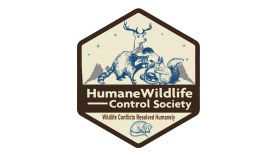Humane Wildlife Control in Annapolis, MD
The Humane Wildlife Control Society recommends non-invasive solutions to resolve human-wildlife conflicts. This includes:
Determining if the issue needs to be addressed at all
Opting for preventative measures first
Opting for wildlife exclusion as opposed to trapping
If trapping is the only way to solve the problem do so humanely
The Humane Wildlife Control Society screens candidates prior to recommendation. Our process requires any company we recommend to meet the following criteria:
Is properly licensed in Maryland for wildlife control
Carries appropriate business licenses and insurance
Complies with all Maryland laws and regulations for wildlife control
Adheres to the humane principles listed above.
In Annapolis, Maryland we recommend Humane Wildlife Removal Annapolis for professional wildlife control services. This is a private company that charges for their services.
Contact Information:
Wildlife Removal Annapolis
410-774-5789
If you have any wildlife issues that can be handled by the state government agency for free, the Maryland Wildlife Commission can help.
State Contact Information: (410) 260-8540
The State Department of Agriculture may also be able to address your wildlife problem for no charge.
USDA Contact Information: (410) 841-5882
Wildlife Control Services in Annapolis, Maryland: A Public Resource
Introduction
Annapolis, Maryland’s unique position at the convergence of the Chesapeake Bay watershed, developed urban areas, and remnant forest ecosystems creates distinct wildlife management challenges. As Maryland’s capital city continues to develop, interactions between residents and wildlife have increased, necessitating professional intervention and public education. This resource provides authoritative information on wildlife control services in Annapolis, addressing common concerns, regulatory frameworks, and best practices for humane and effective wildlife management.
Wildlife Species of Concern in Annapolis
Common Urban Wildlife
The Annapolis region supports diverse wildlife populations that frequently interact with urban environments:
Raccoons frequently establish denning sites in attics, chimneys, and crawlspaces, particularly during breeding season (January through June). Their dexterous forepaws enable them to manipulate latches, open containers, and access seemingly secure areas.
Virginia Opossums commonly seek shelter under decks, in sheds, and within woodpiles. While generally non-aggressive, their presence often raises concerns about disease transmission, though they actually consume significant numbers of ticks that transmit Lyme disease.
Eastern Gray Squirrels frequently enter attics during nesting seasons (December-February and May-June). Their gnawing behavior can damage electrical wiring, creating fire hazards.
Groundhogs (woodchucks) establish extensive burrow systems that can undermine foundations, walkways, and retaining walls throughout the Annapolis area.
Specific Annapolis Concerns
Several wildlife management issues are particularly relevant to Annapolis:
Waterfowl management requires specialized approaches given Annapolis’s extensive waterfront. Canada geese populations create nuisance issues in parks, golf courses, and waterfront properties.
Bat colonies often establish in historic buildings throughout Annapolis’s preservation districts, requiring control methods that comply with both wildlife regulations and historic preservation requirements.
Deer populations in surrounding Anne Arundel County impact landscaping, create traffic hazards, and raise concerns about tick-borne illnesses.
Migratory bird species protected under federal law nest on buildings and waterfront structures, requiring careful timing for exclusion or deterrent installation.
Regulatory Framework
State Regulations
Wildlife control in Annapolis operates under Maryland Department of Natural Resources (DNR) jurisdiction:
The Maryland Wildlife and Heritage Service establishes and enforces regulations regarding wildlife handling, including required permits for certain species and methods.
Licensed Wildlife Control Operators (WCOs) must complete state-certified training and maintain current permits to legally handle most wildlife situations.
Certain species, including deer and migratory birds, have additional regulatory protections requiring specialized permits.
Local Ordinances
Annapolis Municipal Code addresses several wildlife-related concerns:
City ordinances prohibit feeding wildlife in public spaces to prevent habituation and nuisance behaviors.
Regulations govern the installation of wildlife exclusion devices on buildings within the Historic District.
Property maintenance codes require addressing conditions that attract wildlife, including proper waste containment.
Professional Wildlife Control Services
Qualifications and Credentials
When selecting wildlife control services in Annapolis, verify:
State licensing: All wildlife control operators must possess current Maryland DNR permits.
Insurance and bonding: Legitimate operations maintain appropriate liability coverage for property damage or injuries.
Professional affiliations: Membership in organizations such as the National Wildlife Control Operators Association indicates commitment to industry standards.
Specialized certifications: Additional training in humane handling, wildlife diseases, or structural repair indicates higher service quality.
Service Components
Comprehensive wildlife control typically includes:
Inspection and assessment: Thorough property evaluation to identify entry points, attractants, and evidence of wildlife activity.
Species identification: Accurate identification ensures appropriate and legal control methods.
Exclusion plan: Development of a customized strategy for removing animals and preventing re-entry.
Remediation: Cleanup of nesting materials, waste, and associated contaminants.
Structural repairs: Sealing entry points and repairing damage caused by wildlife.
Prevention consultation: Recommendations for preventing future wildlife conflicts.
Humane and Effective Control Methods
Exclusion Techniques
Non-lethal exclusion represents the preferred approach for most situations:
One-way devices allow animals to exit structures but prevent re-entry.
Passive deterrents including physical barriers, ultrasonic devices, and taste/scent repellents discourage wildlife presence.
Habitat modification reduces property attractiveness to target species.
Trapping Considerations
When trapping becomes necessary:
Live trapping must follow Maryland DNR regulations regarding trap types, inspection frequency, and release locations.
Timing considerations account for breeding seasons to prevent orphaning dependent young.
Release restrictions dictate legal transportation distances and appropriate habitat types for relocated animals.
Special Cases
Some wildlife situations require specialized approaches:
Rabies vector species (raccoons, foxes, bats, and skunks) require additional precautions and coordination with health authorities.
Bird control must comply with Migratory Bird Treaty Act protections.
Venomous snakes require specialized handling techniques and equipment.
Public Health and Safety Considerations
Disease Transmission
Several wildlife-associated diseases occur in the Annapolis region:
Rabies remains endemic in local raccoon, fox, and bat populations, with Anne Arundel County reporting multiple positive cases annually.
Leptospirosis can be transmitted through contact with wildlife urine, particularly in enclosed spaces like crawlspaces and attics.
Histoplasmosis risk increases where bird or bat droppings accumulate, particularly in confined spaces.
Structural Concerns
Wildlife can compromise building integrity:
Chewed electrical wiring creates fire hazards, particularly from rodent activity.
Soiled insulation reduces energy efficiency and creates odor problems.
Damaged vapor barriers can lead to moisture issues and subsequent mold growth.
Compromised structural elements may occur from extensive gnawing or nesting behaviors.
Prevention Strategies for Annapolis Residents
Property Maintenance
Regular maintenance significantly reduces wildlife conflicts:
Inspect rooflines, soffits, and foundations quarterly for potential entry points.
Maintain tree canopies at least 10 feet from structures to prevent roof access.
Secure crawlspace vents and utility penetrations with appropriate wildlife-resistant materials.
Address water management issues that create attractive habitat.
Resource Management
Controlling attractants dramatically decreases wildlife problems:
Secure waste containers using wildlife-resistant designs, particularly important in Annapolis’s historic districts where traditional waste management options may be limited.
Manage bird feeders properly by using catch trays and appropriate placement.
Store pet food indoors and feed pets inside or remove outdoor dishes promptly after feeding.
Harvest fruits and vegetables promptly from gardens to prevent attracting wildlife.







